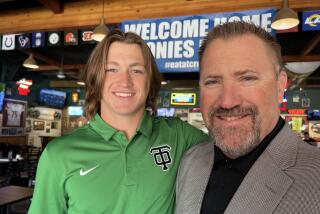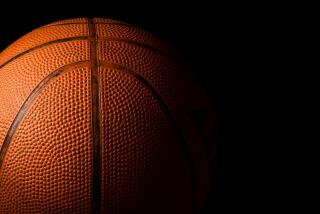After Army, Navy and Air Force, What’s Left? : Most Fans Don’t Even Know a Football Team Exists at Coast Guard Academy
- Share via
NEW LONDON, Conn. — Yes, we are kaydets, Proud of our corps; Proud of our heroes brave Who guard every shore . . . --Alma Mater, U.S. Coast Guard Academy
High on a hill overlooking the west bank of the Thames River is Cadet Memorial Field, home of the U.S. Coast Guard Academy’s football team.
The Coast Guard Academy is one of America’s service academies. The best known of these, Army, Navy and Air Force, rank among the powerhouses of collegiate football from time to time.
Coach Fisher DeBerry’s Air Force team, for instance, is 9-0 this year, and ranked fifth in the nation. Army is 7-1. Navy is having a tough time at 3-5.
The Coast Guard Academy’s team?
Many don’t even know the academy exists.
There is no national radio or TV coverage of the Coast Guard Academy football team. There is not even local coverage. And you have to look hard to find a Coast Guard result listed among Saturday’s football games in Sunday papers.
The major academies play such Division I-A teams as Notre Dame, Penn State and one another. Coast Guard Academy, a Division III team, plays such New England teams as Norwich, Rensselaer Polytechnic, Union and Trinity.
The Coast Guard Academy is the smallest of the service academies with an enrollment of 765 cadets. Even the Merchant Marine Academy at Kings Point, N.Y., has a four-figure enrollment.
There certainly is no recruiting of football players here, and hardly a year passes when one of the stars turns out to be a cadet who never played high school football.
This year’s leading receiver, for instance, John Rendon, 19, a sophomore from Hudson, N.H., never played football in his life before coming to the academy.
Every year, the service academies compete for the coveted Commander in Chief’s trophy, signifying the best team among service academies.
That is Army, Navy and Air Force compete.
Not Coast Guard.
No wonder they call it the orphan academy.
“Fight on--to victory. Fight on, fight on, for old CG ...”
There are no cheerleaders at the Coast Guard Academy. The freshman class, known collectively as the Swabs, is traditionally assigned by upper classmen to cheer loud and long. Every cadet is required to attend every home game. There’s a reason for that. Not many others show up.
Whenever Coast Guard scores, the entire freshman class pours out of the stands and runs behind a goal post, where each swab does as many pushups as the home team’s score to that point.
Coast Guard has two nicknames, Cadets and Bears, and a real live bear was the team’s mascot for 58 years--actually, there were 31 different bears in that period--until last year, when Connecticut banned the ownership of dangerous wild animals except by zoos and laboratories.
It was just as well. Objee, as the bear was always called--short for objectionable--was forever escaping and raising hell. One year, students from archrival Norwich University in Northfield, Vt., kidnaped Objee in a van and began driving north toward Vermont. Objee took exception to that and destroyed the inside of the vehicle.
Long before the students had reached the state line, they phoned the Coast Guard Academy, admitted their crime and said they were hurrying back as quickly as possible to return the destructive beast.
This year, the mascot is a cadet dressed in bear suit.
Coast Guard has a 3-6 record going into its final game of the season Saturday at home against the Marist College Red Foxes of Poughkeepsie, N.Y.
It’s been a typical season. The last winning year was 1977, and in its 61 seasons of football before this year, Coast Guard had 18 winning teams, 35 losers and 8 that broke even.
Otto Graham, Northwestern’s All-American quarterback who then starred for years with the Cleveland Browns, was the academy’s most successful football coach. His best year, as well as the school’s, was 1963, when the Cadets had an 8-0 record.
Graham coached Coast Guard for nine years in two installments, from 1959 through ‘65, then again in 1974 and ’75. He was athletic director from 1970 until he retired last year. Between his stints at Coast Guard, he coached the Washington Redskins, from 1966-68.
The coach these days is Bob (Campi) Campiglia, 44. “No way is this like football at the other academies,” he readily admitted. He ought to know, too, since he’s in his fourth year as head coach and was an assistant for 10 years before that.
“They have their thing, we have ours,” he said. “It’s a matter of knowing the house you live in. Envious? No. But it would be nice if we were mentioned when people talked about service academies.
“Every time you hear about the academies it’s the Army, Navy, Air Force. Never the Coast Guard.”
Campiglia talked about other academies giving appointments to athletes to play football and having special perks for football players, like training tables and ample time for practice.
“We practice less than two hours a day, Monday through Friday; squeeze it in between academic and military activities,” he said.
“The cost of our program is a drop in the bucket compared to that at Air Force, Army and Navy.”
DeBerry of Air Force, Coach Jim Young of Army, and Coach Gary Tranquill of Navy are minor media celebrities. Campiglia is a virtual unknown.
Cadets here are from the upper 10% of their high school classes. There’s no such thing as a C student here. It’s tough. Out of 7,800 who applied for the Coast Guard Academy this year, only 290 were accepted, based strictly on nationwide competition.
Nearly 50% of those who enter wash out. Half of the Coast Guard’s 4,000 officers are academy graduates.
One of the best Coast Guard players from California was Billy Bryant of Ojai, now Lt. Billy Bryant, a defensive back who set the school record for pass interceptions, 11, in 1975.
More to Read
Get our high school sports newsletter
Prep Rally is devoted to the SoCal high school sports experience, bringing you scores, stories and a behind-the-scenes look at what makes prep sports so popular.
You may occasionally receive promotional content from the Los Angeles Times.






